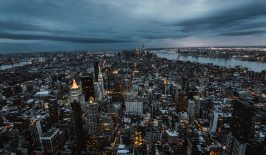With traffic congestion and air pollution seriously undermining public and environmental health in Chinese megacities, heads have been working together to smarten up the transport infrastructure, and a giant straddling bus may just be the ticket!
According to the World Health Organisation, air pollution is responsible for the death of some seven million people globally each year. Rapid urbanisation and an inadequate transport infrastructure are two of the reasons why megacities worldwide are suffering high level of air pollution and traffic congestion. Images of a smoggy Beijing skyline have become the norm, and are a stark reminder of what such congested urban settings mean for everyday quality of life.
Apart from health and environmental costs, traffic congestion amounts to serious economic losses too: a 2014 survey conducted by Peking University’s National Development Research Institute – reported in the China Daily – found that Beijing’s annual bill for traffic congestion amounts to 70 billion yuan (11.3 billion USD).
To help ease traffic congestion and air pollution, the Shenzen Hashi Future Parking Equipment has been working on a scale model of an electric straddling bus which travels on rail tracks mounted to existing roads. The model was unveiled at the 2016 International High-Tech Expo in Beijing. The passenger compartment of the straddling bus is two traffic lanes wide and sits high above the road on two elevated rail tracks, running along each side of the road, leaving the road below clear for passing traffic: vehicles up to two metres-high can easily pass under the bus.
Powered by electricity, it is estimated that the straddling bus – also known as Land Airbus, or Transit Elevated Bus – would travel up to 60 Km/hour, carry up to a whopping 1400 passengers, could replace up to 40 conventional buses, save up to 800 tonnes of fuel per year, and prevent the annual release of up to 2800 tonnes of CO2.
According to Chief Engineer Soung Youzhou, much like a subway or tunnel, the Land Airbus would save lots of road space, but compared to the cost of building a subway, at an estimated 16 per cent of the cost, and at a fraction also of the time needed to manufacture and build it.
A real version of the scale model is currently under construction in China in the eastern city of Changzhou, where a feasibility test is set to commence by August this year. Other cities in China are following with interest any developments in what could soon help them greatly reduce traffic congestion and air pollution. And with such a futuristic design, Land Airbuses will no doubt give public transport more generally a well-deserved boost. Who wouldn’t want to ride on one?
Here’s a computer simulation of how it would all work:



